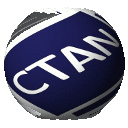Directory macros/latex/contrib/kvmap
README.md
The kvmap package v0.3.5
This LaTeX package allows the creation of (even large) Karnaugh maps. It provides a tabular-like input syntax and support for drawing bundles (implicants) around adjacent values.
Code example:
\begin{kvmap}
\begin{kvmatrix}{a,b,c,d}
0 & 1 & 1 & 0\\
1 & 0 & 0 & 1\\
0 & 0 & 0 & 1\\
0 & 1 & 1 & 1\\
\end{kvmatrix}
\bundle{3}{3}{2}{3}
\bundle[color=blue]{3}{2}{3}{1}
\bundle[invert=true,reducespace=2pt,overlapmargins=6pt]{1}{0}{2}{3}
\bundle[invert=true,reducespace=2pt]{0}{1}{3}{1}
\end{kvmap}
`kvmap` is released under the terms of the LPPL 1.3c and maintained by Ben Frank.Download the contents of this package in one zip archive (100.1k).
kvmap – Create Karnaugh maps with LaTeX
This LaTeX package allows the creation of (even large) Karnaugh maps. It provides a tabular-like input syntax and support for drawing bundles (implicants) around adjacent values. It is based on an answer at StackExchange.
| Package | kvmap |
| Home page | https://gitlab.com/benfrank/kvmap |
| Bug tracker | https://gitlab.com/benfrank/kvmap/-/issues |
| Version | 0.3.5 2020-09-16 |
| Licenses | The LaTeX Project Public License 1.3c |
| Copyright | 2018–2020 Ben Frank |
| Maintainer | Ben Frank |
| Contained in | TeX Live as kvmap MiKTeX as kvmap |
| Topics | Maths Engineering |
| See also | karnaughmap karnaugh-map |
